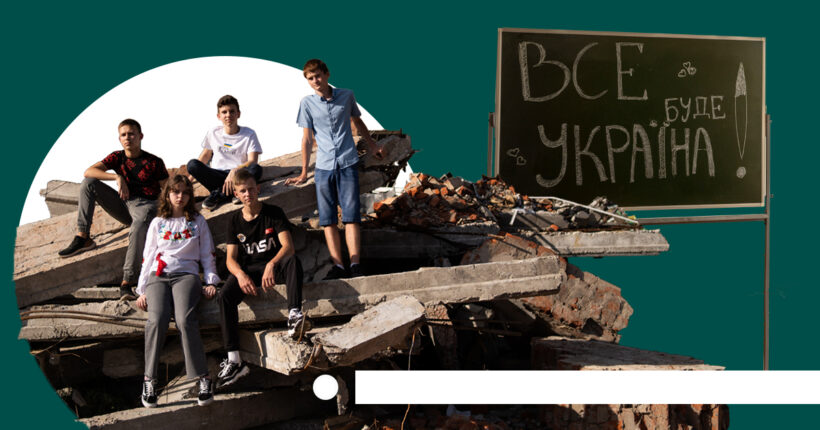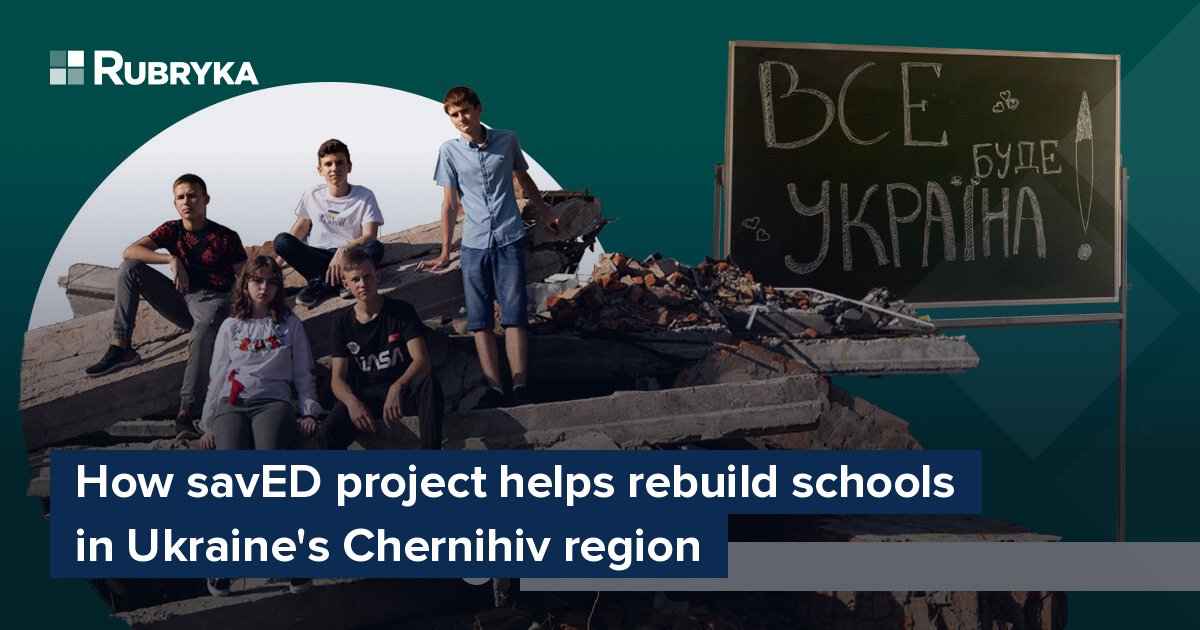
What's the problem?
Schools and kindergartens destroyed by russia
During russia's full-scale invasion of 2022, almost the entire Chernihiv region was captured by enemy invaders. From February–early April, there were battles for Chernihiv, which ended with the final liberation of the occupied part of the region. But civilian houses and city infrastructure suffered significant destruction during those battles. According to preliminary estimates, 3.5 thousand buildings were damaged, and 38 war crimes against the region's cultural heritage were recorded.

School No. 18 in the city of Chernihiv was destroyed by a russian aerial bomb at the beginning of March. Source: savED on Facebook
The russian military has made numerous strikes on schools and kindergartens. Of the 34 schools in Chernihiv, the russians damaged 25 and destroyed two more entirely. And among the 52 kindergartens that worked until February 24, only 15 survived.
After the region's liberation, the question arose of restoring educational institutions or finding an alternative to help schoolchildren continue studying even under challenging conditions.
What is the solution?
Restoration of educational infrastructure
The "savED" charitable foundation focused on restoring educational institutions in Chernihiv and constructing new premises that could become an alternative to schools. The foundation was registered as a legal entity in July of this year, but its work began in April.

The charity fund team. Source: savED on Facebook
"We see that the russians are waging a targeted war against educational institutions. They are still shelling schools, lyceums, kindergartens, and universities. All this is a purposeful activity to destroy education. And we believe that Chernihiv became one of the reasons why the russians did not go further, why they surrendered, and why they did not reach Kyiv from the other side.
But the occupiers stood around the city for more than a month, constantly shelling and simply destroying it. Therefore, we decided to start the restoration of the educational infrastructure from this city and later move to the region. This is the least we can do to say 'thank you' for saved Kyiv," says Lilia Drozdyk.

Lilia Drozdyk. Source: Lilia's personal archive.
According to Lilia, 80 million dollars are currently needed to restore all schools in Chernihiv. Restarting the educational process cannot be done without the help of foundations and volunteer organizations.
How does it work?
Alternative to destroyed schools
The first thing that savED started with was the assessment of damage to educational institutions. According to the foundation's team, this is a relatively expensive and lengthy process for the city. Therefore, help from savED could save the city budget and allow them to be redirected to something else.
Having received support from the Embassy of Finland in Ukraine and the Osvit public organization, the savED team began assessing the damaged schools of Chernihiv in the spring. They continued the same system in partnership with the large educational initiative GoGlobal, a co-founder of savED. In addition, the team enlisted the support of Finn Church Aid.

The heating system in one of the schools in Chernihiv has been destroyed. Source: savED on Facebook
The first stage was a technical assessment of the damage. Currently, the evaluation of the state of all educational institutions in Chernihiv is being completed. At the same time, the savED team communicates with the city authorities, defining priorities and planning further recovery. Thus, with the Department of Education, savED identified several priority schools on the restoration of which they are working together. For example, in one of the schools of Chernihiv, the city ensured the repair of broken windows, and savED restored classrooms damaged by the blast wave.
The foundation is also working on setting up digital educational centers in communities significantly affected during active military operations in the spring. The goal is to find a faster and cheaper alternative that allows children to continue their education. After all, children often do not have gadgets to learn at least remotely in such communities, especially in villages.

Dismantling stage in the damaged computer science classroom at school #20 in Chernihiv. Source: savED on Facebook
"It takes several years and several million dollars to build a school. We understand that children need to learn today. That's why we create digital educational centers—comfortable and equipped spaces for children with gadgets, didactic materials, and literature, where they can join an online lesson, attend an additional class after school, read or just chat with friends.
At the same time, we set ourselves the goal of building something fundamentally new on the site of the destroyed one, and not just rebuilding the walls that were there before," Lilia Drozdyk explains.

Reconstruction and cleaning. Source: savED on Facebook
Another area of work is the arrangement of shelters in schools and kindergartens. After all, safety is mandatory for children to attend an educational institution. Sometimes formats can be combined. So, in one of the schools in Chernihiv, a digital educational center was set up right in the school's basement. Now it is both a shelter and an educational space.
Does it work?
Thousands of children can learn again
Since its launch, the foundation has managed to complete a detailed assessment of each damaged school in Chernihiv. This helped to understand the extent of destruction and to start raising funds for their further restoration or repair. And if the fund has made the first assessments with the help of the Embassy of Finland and NGO Osvit, now the foundation cooperates with many partners, public organizations, and other foundations that contribute to the development of the cause.
In addition, the savED foundation has already:
- publicly presented its work in Chernihiv in August and held a public discussion, "Education and War," which gathered Ukrainian and world opinion leaders in the field of education to discuss and formulate a plan for its restoration and development during and after the war.
- equipped shelters in two kindergartens in Chernihiv, designed for 711 children, in the summer, laying paving stones on the floor of the shelters, which was just dirt, and installing mobile toilets.

Arrangement of shelters. Source: savED on Facebook
- started to restore the computer science class at school #20 in Chernihiv. The blast wave blew out the school's windows, and the walls and ceiling of the classroom were cut with debris. The team has dismantled damaged elements in the school and is fundraising for further restoration.
- managed to fully restore the previously damaged class of younger students in the same school, replacing the broken windows, repairing the walls and ceiling, and restoring the floor.
- created digital educational centers in the communities of Kyiv and Chernihiv regions affected by the war, where the occupiers looted computers.
- visited dozens of towns and villages in the Chernihiv and Kyiv regions since April and studied the condition of the buildings of educational institutions.
- been arranging consultations with international and donor organizations to help the city authorities and donors jointly implement projects to restore educational infrastructure, arrange educational spaces, etc.
- held summer activities for the children of Chernihiv and several communities in the region to distract and rehabilitate them after the experience with the support of Finn Church Aid and in partnership with the NGO DOCCU and GoGlobal. The project was implemented in 17 schools in Chernihiv and four regional communities. In total, they reached 6,000 children.
Currently, savED has started negotiations with IREX on the construction of a modular school in the village of Zahaltsi, where educational institutions and the entire infrastructure were severely damaged in the spring due to the offensive of the occupiers. With the American non-profit organization Nova Ukraine, savED started fundraising campaigns in the USA to raise funds for restoring the damaged educational infrastructure of Chernihiv.
Even more helpful solutions!
Change Drivers and word of mouth
In autumn, the savED" foundation team became one of the winners of the annual Change Drivers award, which recognizes the best initiatives through public voting, the activities of which help the recovery and development of the country. According to Lilia Drozdyk, they found out about the Change Drivers in the foundation through "word of mouth."
"We learned from friends of our friends. And to be honest, we were interested in participating, but we didn't circulate the vote, so it was really nice when the results were announced, and we were one of the winners!" says Lilia.

Lilia receives an award. Source: savED on Facebook
The charity fund savED received a 10 thousand hryvnia award. The funds received will be used to continue the reconstruction of classrooms in Chernihiv, which will be another contribution to restoring the educational process in the region.
But the rest of the necessary funds are still being raised. As soon as they manage to accumulate the required amount, they will begin a new repair. And the children will get a chance to get a decent education in proper conditions.







